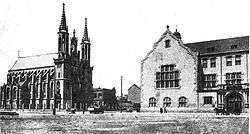Church of the Immaculate Conception, Baku
| The Church of the Virgin Mary’s Immaculate Conception Müqəddəs Bakirə Məryəm kilsəsi | |
|---|---|
| Basic information | |
| Location | Baku, Azerbaijan |
| Affiliation | Roman Catholic |
| Year consecrated | 2007 |
| Ecclesiastical or organizational status | Cathedral |
| Architectural description | |
| Architect(s) | Paolo Ruggiero |
| Architectural type | Church |
| Architectural style | Neo Gothic |
| Completed | 2006 |
The Church of the Virgin Mary’s Immaculate Conception (Azerbaijani: Müqəddəs Bakirə Məryəm kilsəsi, Russian: Церковь Непорочного Зачатия Пресвятой Девы Марии) is a Roman Catholic church in Baku, Azerbaijan.
The original church - The Church of the Blessed Virgin Mary's Immaculate Conception (Polish: Kościół Niepokalanego Poczęcia Najświętszej Maryi Panny; Russian: Храм Непорочного Зачатия Пресвятой Девы Марии; Azeri: Müqəddəs Bakirə Məryəmin Məsum Hamiləliyi şərəfinə kilsə) operated from 1915 to 1931, when it was ordered destroyed by the Soviet government.
In 2006, a new Catholic church bearing the same name was rebuilt in a different spot of Baku. On 29 April 2007 the new church was consecrated by Apostolic Nuncio in Transcaucasia Monsignor Claudio Gugerotti.
The Old Church

Baku's Catholic community was recognized as a separate parish in 1882, thus seceding from the Tetritsq'aro Catholic parish.[1] The fifty-metre high church was built as a place of worship primarily for Polish residents of Baku (then part of the Russian Empire) who had initially held their masses in parochial houses and had sought legal permission for the construction of a Catholic church. Even though the permission was given in 1894, due to money shortage, it was not until 1909 that the construction of the church started. The only financial source were donations from the congregation, which consisted mostly of middle- and low-income families. Civil engineer Józef Płoszko and general contractor Haji Gasimov were in charge of the project. The church was built in the Neo Gothic architectural style. As a result of the Soviet Union's anti-religious campaign, in 1931 the Church of the Virgin Mary’s Immaculate Conception was destroyed. In 1937, its only senior priest Stefan Demurov (a Georgian Catholic) was sent to a labour camp, where he died a year later. The site is now occupied by the Shahriyar Club (earlier known as the Dzierżyński Club).
The New Church
In 1997, the Catholic community of Baku was re-established. After Pope John Paul II's visit to Azerbaijan in 2002, it was granted land to build a new church.[2] The cornerstone of the new church was blessed by John Paul II.[3] The new Church of the Virgin Mary’s Immaculate Conception was built in 2006, in a different spot of Baku according to the Italian architect Paolo Ruggiero's project. The style of the building will be New Gothic and will in some ways recall the facade of the original church.[3] The church was designed to have a pastoral center and a residency for priests.[3] The statue of the Virgin Mary by local sculptors was set up over the entrance of the Church which has 200 benches. The church bells were a present from Lech Kaczyński, then President of Poland.[4] On 29 April 2007 the Apostolic Nuncio in Transcaucasia Monsignor Claudio Gugerotti administered the rite of consecration of the Church.[5] The church was then also dedicated on Sunday, March 7th, 2008 by Cardinal Tarcisio Bertone.[6]
See also
References
- ↑ (Azerbaijani) Azerbaijan: History of the Religions. Azerbaijan.az. Retrieved 23 December 2006.
- ↑ "Foundation-laying Ceremony of Catholic Church Held in Baku". Today.az. September 13, 2005. Retrieved 2006-08-19.
- 1 2 3 Zenit Staff (2005-09-14). "Azerbaijani Catholics Get Papal Praise". Zenit. Retrieved 2014-04-23.
- ↑ History of the Catholic Church in Azerbaijan. Polonia Azerbaijan.
- ↑ "The Church of the Virgin Mary's Immaculate Conception". Catholic.az. 2007. Retrieved 2014-04-23.
- ↑ Zenit Staff (2008-03-09). "Azerbaijan Inaugurates 1st Catholic Church". Zenit. Retrieved 2014-04-23.
External links
- Catholic Church in Azerbaijan, Retrieved 2014-04-23
Coordinates: 40°25′00″N 49°53′00″E / 40.4167°N 49.8833°E